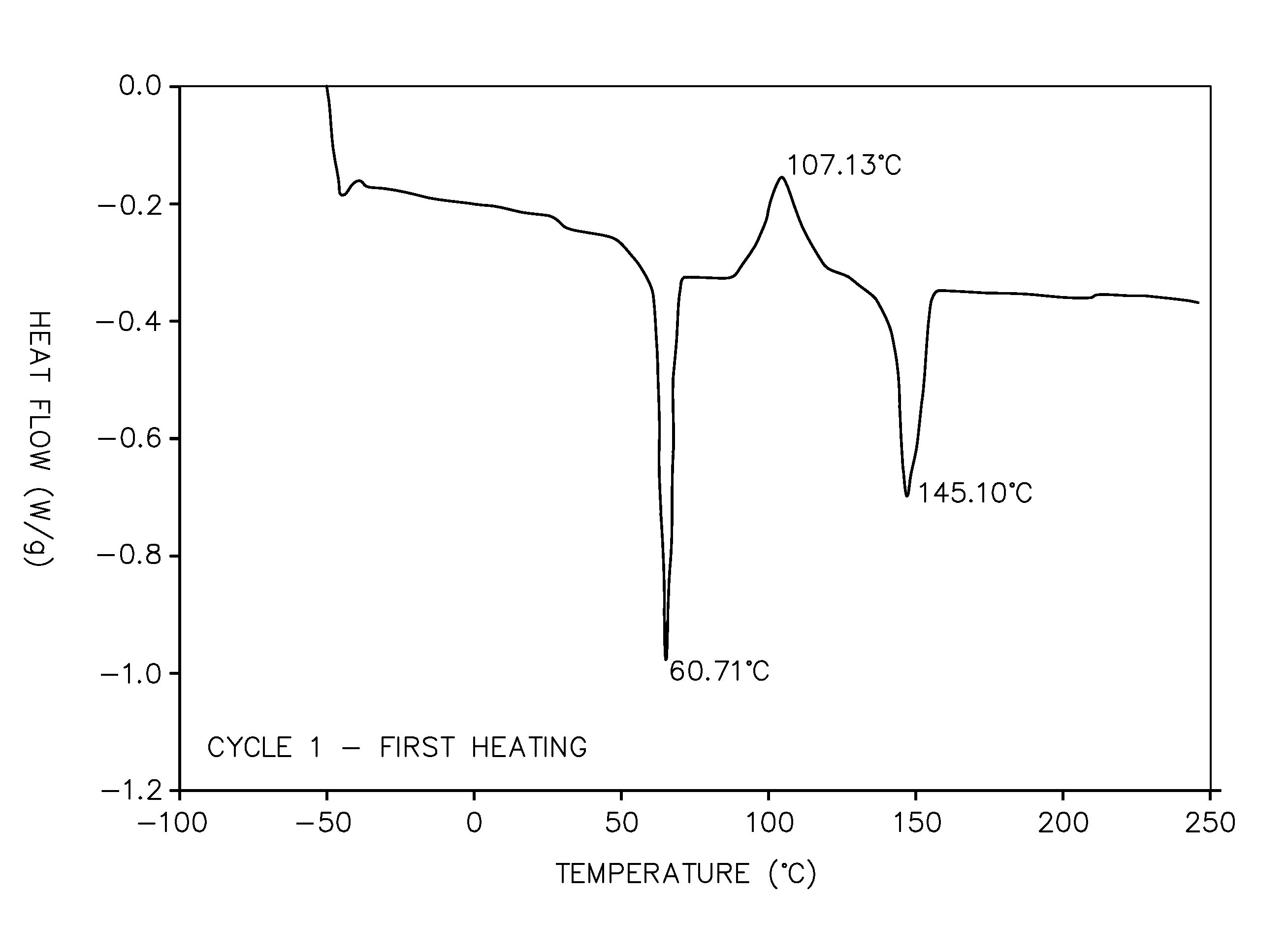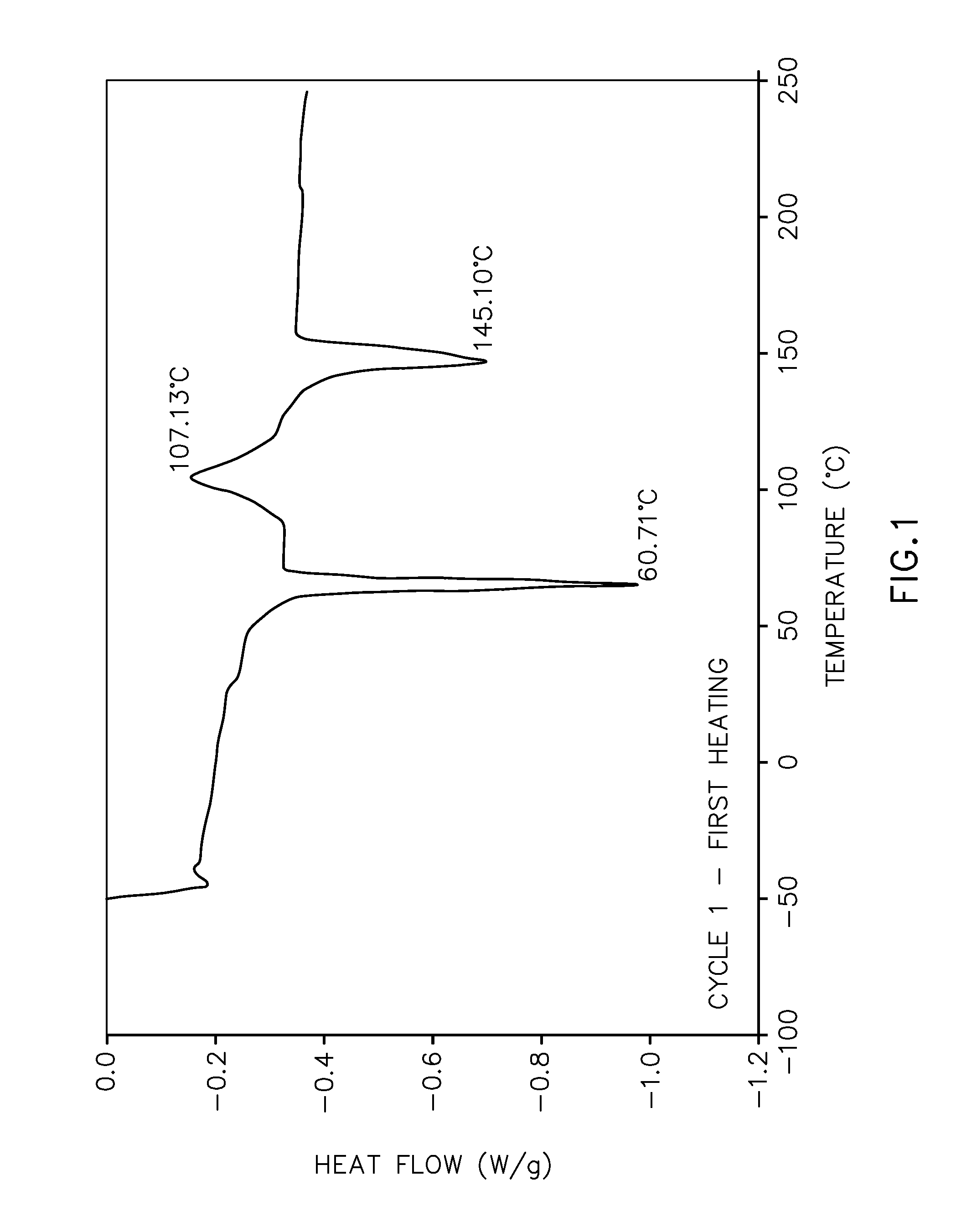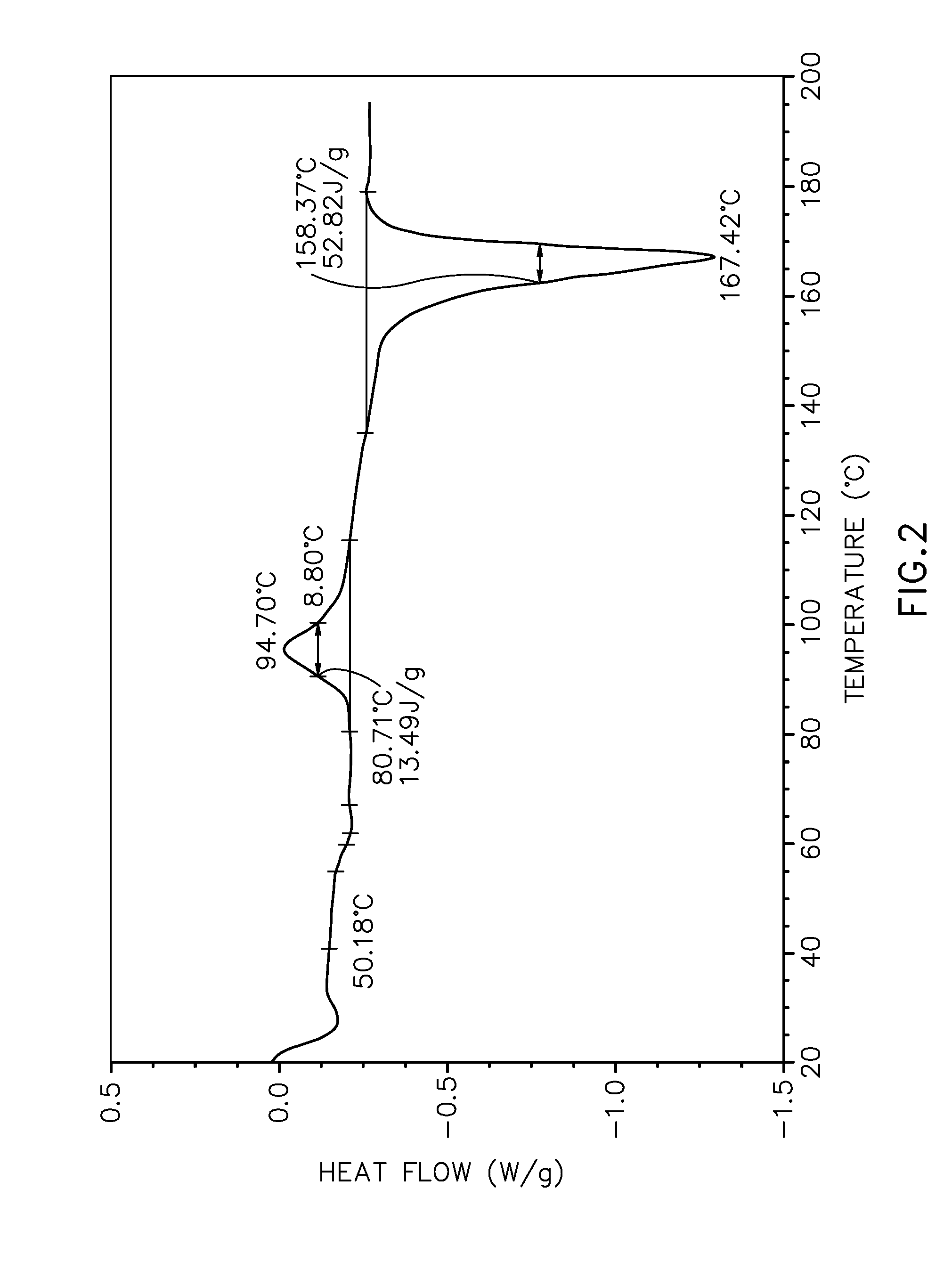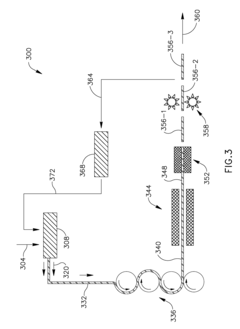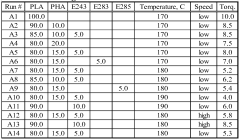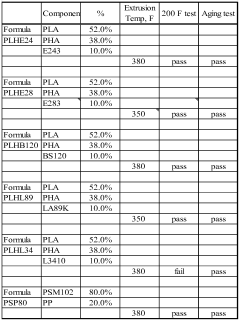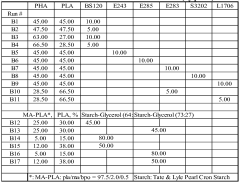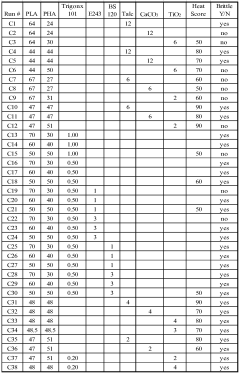PLA and Its Contribution to Low Carbon Footprint Products
JUN 25, 20259 MIN READ
Generate Your Research Report Instantly with AI Agent
Patsnap Eureka helps you evaluate technical feasibility & market potential.
PLA Technology Overview and Objectives
Polylactic acid (PLA) has emerged as a promising bioplastic material in the quest for sustainable and environmentally friendly alternatives to conventional petroleum-based plastics. This biodegradable polymer, derived from renewable resources such as corn starch or sugarcane, has gained significant attention in recent years due to its potential to reduce carbon footprints across various industries.
The development of PLA technology can be traced back to the 1920s when it was first synthesized by Wallace Carothers. However, it wasn't until the late 20th century that PLA began to gain traction as a viable commercial product. The evolution of PLA technology has been driven by the growing awareness of environmental issues and the need for sustainable materials in manufacturing processes.
In recent years, advancements in PLA production techniques have led to improved material properties and cost-effectiveness, making it increasingly competitive with traditional plastics. The primary objective of PLA technology is to provide a renewable and biodegradable alternative to petroleum-based plastics while maintaining comparable performance characteristics.
One of the key advantages of PLA is its ability to significantly reduce carbon emissions throughout its lifecycle. From production to disposal, PLA offers a lower carbon footprint compared to conventional plastics. This is primarily due to its plant-based origins, which sequester carbon dioxide during growth, and its biodegradability, which reduces long-term environmental impact.
The current technological landscape of PLA is focused on enhancing its mechanical properties, thermal stability, and processability to expand its applications across various industries. Researchers are exploring methods to improve PLA's heat resistance, flexibility, and barrier properties to make it suitable for a wider range of products, from packaging materials to automotive components.
Looking ahead, the future of PLA technology is likely to involve further innovations in production processes, blending techniques, and modifications to enhance its performance characteristics. The development of new PLA grades with tailored properties for specific applications is expected to drive its adoption in sectors such as electronics, textiles, and medical devices.
As global efforts to combat climate change intensify, PLA's role in creating low carbon footprint products is set to become increasingly significant. The technology's potential to replace traditional plastics in various applications while offering environmental benefits aligns with the growing demand for sustainable materials in consumer and industrial markets.
The development of PLA technology can be traced back to the 1920s when it was first synthesized by Wallace Carothers. However, it wasn't until the late 20th century that PLA began to gain traction as a viable commercial product. The evolution of PLA technology has been driven by the growing awareness of environmental issues and the need for sustainable materials in manufacturing processes.
In recent years, advancements in PLA production techniques have led to improved material properties and cost-effectiveness, making it increasingly competitive with traditional plastics. The primary objective of PLA technology is to provide a renewable and biodegradable alternative to petroleum-based plastics while maintaining comparable performance characteristics.
One of the key advantages of PLA is its ability to significantly reduce carbon emissions throughout its lifecycle. From production to disposal, PLA offers a lower carbon footprint compared to conventional plastics. This is primarily due to its plant-based origins, which sequester carbon dioxide during growth, and its biodegradability, which reduces long-term environmental impact.
The current technological landscape of PLA is focused on enhancing its mechanical properties, thermal stability, and processability to expand its applications across various industries. Researchers are exploring methods to improve PLA's heat resistance, flexibility, and barrier properties to make it suitable for a wider range of products, from packaging materials to automotive components.
Looking ahead, the future of PLA technology is likely to involve further innovations in production processes, blending techniques, and modifications to enhance its performance characteristics. The development of new PLA grades with tailored properties for specific applications is expected to drive its adoption in sectors such as electronics, textiles, and medical devices.
As global efforts to combat climate change intensify, PLA's role in creating low carbon footprint products is set to become increasingly significant. The technology's potential to replace traditional plastics in various applications while offering environmental benefits aligns with the growing demand for sustainable materials in consumer and industrial markets.
Market Demand for Eco-friendly Materials
The market demand for eco-friendly materials has experienced significant growth in recent years, driven by increasing environmental awareness and stringent regulations aimed at reducing carbon emissions. Polylactic acid (PLA), a biodegradable and renewable polymer derived from plant-based sources, has emerged as a promising alternative to traditional petroleum-based plastics in various industries.
Consumer preferences have shifted towards sustainable products, with a growing segment of environmentally conscious customers willing to pay a premium for eco-friendly alternatives. This trend has created a substantial market opportunity for PLA-based products across multiple sectors, including packaging, textiles, and consumer goods. The packaging industry, in particular, has seen a surge in demand for PLA materials due to their compostable nature and potential to reduce plastic waste.
The global PLA market has been expanding rapidly, with projections indicating continued growth in the coming years. This growth is fueled by the material's versatility, biodegradability, and potential to reduce carbon footprints compared to conventional plastics. Industries such as food packaging, disposable cutlery, and 3D printing filaments have shown significant interest in adopting PLA-based solutions to meet sustainability goals and consumer expectations.
Government initiatives and regulations promoting the use of biodegradable materials have further bolstered the demand for PLA. Many countries have implemented policies to reduce single-use plastics and encourage the adoption of eco-friendly alternatives, creating a favorable regulatory environment for PLA products. This legislative support has incentivized businesses to invest in PLA technology and product development, driving market growth.
The textile industry has also recognized the potential of PLA fibers as a sustainable alternative to synthetic materials. PLA-based fabrics offer properties similar to polyester while providing improved breathability and moisture-wicking capabilities. As the fashion industry faces increasing pressure to reduce its environmental impact, the demand for PLA fibers in clothing and home textiles is expected to rise.
Despite the growing demand, challenges remain in scaling up PLA production and improving its cost-competitiveness compared to traditional plastics. However, ongoing research and development efforts are focused on enhancing PLA's properties, reducing production costs, and expanding its applications. As technological advancements continue and economies of scale are achieved, the market demand for PLA and other eco-friendly materials is poised for substantial growth, contributing to the development of low carbon footprint products across various industries.
Consumer preferences have shifted towards sustainable products, with a growing segment of environmentally conscious customers willing to pay a premium for eco-friendly alternatives. This trend has created a substantial market opportunity for PLA-based products across multiple sectors, including packaging, textiles, and consumer goods. The packaging industry, in particular, has seen a surge in demand for PLA materials due to their compostable nature and potential to reduce plastic waste.
The global PLA market has been expanding rapidly, with projections indicating continued growth in the coming years. This growth is fueled by the material's versatility, biodegradability, and potential to reduce carbon footprints compared to conventional plastics. Industries such as food packaging, disposable cutlery, and 3D printing filaments have shown significant interest in adopting PLA-based solutions to meet sustainability goals and consumer expectations.
Government initiatives and regulations promoting the use of biodegradable materials have further bolstered the demand for PLA. Many countries have implemented policies to reduce single-use plastics and encourage the adoption of eco-friendly alternatives, creating a favorable regulatory environment for PLA products. This legislative support has incentivized businesses to invest in PLA technology and product development, driving market growth.
The textile industry has also recognized the potential of PLA fibers as a sustainable alternative to synthetic materials. PLA-based fabrics offer properties similar to polyester while providing improved breathability and moisture-wicking capabilities. As the fashion industry faces increasing pressure to reduce its environmental impact, the demand for PLA fibers in clothing and home textiles is expected to rise.
Despite the growing demand, challenges remain in scaling up PLA production and improving its cost-competitiveness compared to traditional plastics. However, ongoing research and development efforts are focused on enhancing PLA's properties, reducing production costs, and expanding its applications. As technological advancements continue and economies of scale are achieved, the market demand for PLA and other eco-friendly materials is poised for substantial growth, contributing to the development of low carbon footprint products across various industries.
PLA Production Challenges and Limitations
Despite the promising potential of PLA as a sustainable alternative to traditional plastics, its production process faces several challenges and limitations that hinder widespread adoption and large-scale manufacturing.
One of the primary challenges in PLA production is the high cost of raw materials, particularly lactic acid. The production of lactic acid through fermentation of corn or other starch-rich crops requires significant resources and energy inputs. This results in higher production costs compared to conventional petroleum-based plastics, making PLA less competitive in price-sensitive markets.
Another limitation is the energy-intensive nature of the PLA production process. While PLA is marketed as a low-carbon footprint product, the manufacturing process itself can be energy-intensive, particularly during the polymerization stage. This energy consumption can partially offset the environmental benefits gained from using renewable resources as feedstock.
The scalability of PLA production also presents challenges. Current production capacities are limited compared to traditional plastics, and scaling up to meet growing demand requires substantial investments in infrastructure and technology. This limitation affects the ability to achieve economies of scale and further reduce production costs.
PLA's sensitivity to processing conditions poses another challenge. The material requires precise temperature control during processing to maintain its properties and prevent degradation. This sensitivity can lead to inconsistencies in product quality and increased production complexity, particularly when transitioning from small-scale to large-scale manufacturing.
The limited availability of industrial composting facilities presents a significant barrier to realizing PLA's end-of-life benefits. While PLA is compostable under specific conditions, the lack of widespread industrial composting infrastructure means that many PLA products end up in landfills, where they may not degrade as intended.
Furthermore, PLA's performance limitations in certain applications restrict its use as a direct replacement for conventional plastics. Issues such as low heat resistance, brittleness, and moisture sensitivity can limit PLA's suitability for some high-performance applications, requiring additional research and development to enhance its properties.
Lastly, the competition for feedstock between PLA production and food production raises concerns about food security and land use. As PLA production scales up, there is a potential for increased competition for agricultural resources, which could impact food prices and availability in certain regions.
One of the primary challenges in PLA production is the high cost of raw materials, particularly lactic acid. The production of lactic acid through fermentation of corn or other starch-rich crops requires significant resources and energy inputs. This results in higher production costs compared to conventional petroleum-based plastics, making PLA less competitive in price-sensitive markets.
Another limitation is the energy-intensive nature of the PLA production process. While PLA is marketed as a low-carbon footprint product, the manufacturing process itself can be energy-intensive, particularly during the polymerization stage. This energy consumption can partially offset the environmental benefits gained from using renewable resources as feedstock.
The scalability of PLA production also presents challenges. Current production capacities are limited compared to traditional plastics, and scaling up to meet growing demand requires substantial investments in infrastructure and technology. This limitation affects the ability to achieve economies of scale and further reduce production costs.
PLA's sensitivity to processing conditions poses another challenge. The material requires precise temperature control during processing to maintain its properties and prevent degradation. This sensitivity can lead to inconsistencies in product quality and increased production complexity, particularly when transitioning from small-scale to large-scale manufacturing.
The limited availability of industrial composting facilities presents a significant barrier to realizing PLA's end-of-life benefits. While PLA is compostable under specific conditions, the lack of widespread industrial composting infrastructure means that many PLA products end up in landfills, where they may not degrade as intended.
Furthermore, PLA's performance limitations in certain applications restrict its use as a direct replacement for conventional plastics. Issues such as low heat resistance, brittleness, and moisture sensitivity can limit PLA's suitability for some high-performance applications, requiring additional research and development to enhance its properties.
Lastly, the competition for feedstock between PLA production and food production raises concerns about food security and land use. As PLA production scales up, there is a potential for increased competition for agricultural resources, which could impact food prices and availability in certain regions.
Current PLA Manufacturing Processes
01 Production methods to reduce carbon footprint
Various production methods are being developed to reduce the carbon footprint of PLA manufacturing. These include optimizing fermentation processes, using renewable energy sources, and improving the efficiency of polymerization reactions. Some approaches focus on utilizing waste materials or byproducts as feedstock, further reducing the overall environmental impact.- Production methods to reduce carbon footprint: Various production methods are being developed to reduce the carbon footprint of PLA. These include optimizing fermentation processes, using renewable energy sources in manufacturing, and improving the efficiency of polymerization reactions. Some approaches focus on utilizing waste biomass as feedstock, which can significantly lower the overall environmental impact.
- Biodegradable PLA composites: Researchers are developing biodegradable PLA composites that maintain or improve the material's properties while potentially reducing its carbon footprint. These composites often incorporate natural fibers or other biodegradable materials, which can enhance the overall environmental profile of the final product and contribute to a circular economy approach.
- Life cycle assessment of PLA products: Comprehensive life cycle assessments are being conducted to evaluate the carbon footprint of PLA products from cradle to grave. These studies consider factors such as raw material sourcing, production processes, use phase, and end-of-life scenarios to provide a holistic view of PLA's environmental impact compared to traditional plastics.
- Recycling and upcycling of PLA: Innovative recycling and upcycling techniques for PLA are being developed to extend the material's life cycle and reduce its overall carbon footprint. These methods include chemical recycling to break down PLA into its monomer components, as well as mechanical recycling processes that preserve the polymer structure for reuse in new applications.
- Carbon capture and utilization in PLA production: Emerging technologies are exploring the integration of carbon capture and utilization processes in PLA production. These approaches aim to sequester atmospheric CO2 or utilize industrial carbon emissions as a feedstock for PLA synthesis, potentially creating a negative carbon footprint for the material.
02 Biodegradable PLA composites
Researchers are developing biodegradable PLA composites that maintain or improve the material's properties while potentially reducing its carbon footprint. These composites often incorporate natural fibers, minerals, or other biodegradable materials. The goal is to create materials that have a lower environmental impact throughout their lifecycle, from production to disposal.Expand Specific Solutions03 Recycling and upcycling of PLA
Efforts are being made to improve the recycling and upcycling processes for PLA products. This includes developing more efficient methods for collecting, sorting, and processing used PLA materials. Some innovations focus on chemical recycling techniques that break down PLA into its monomer components, which can then be repolymerized into new PLA products with minimal quality loss.Expand Specific Solutions04 Life cycle assessment of PLA products
Researchers are conducting comprehensive life cycle assessments of PLA products to better understand their overall environmental impact. These studies consider factors such as raw material sourcing, production energy requirements, transportation, use phase, and end-of-life scenarios. The goal is to identify areas for improvement and compare PLA's carbon footprint to that of traditional petroleum-based plastics.Expand Specific Solutions05 Carbon capture and utilization in PLA production
Innovative approaches are being explored to incorporate carbon capture and utilization technologies into PLA production processes. These methods aim to capture CO2 emissions from various sources and use them as a feedstock for PLA synthesis or related processes. By doing so, the overall carbon footprint of PLA production can be reduced, potentially making it a more sustainable alternative to conventional plastics.Expand Specific Solutions
Key Players in PLA Industry
The PLA (Polylactic Acid) market is in a growth phase, driven by increasing demand for sustainable packaging solutions. The global PLA market size is expanding rapidly, with projections indicating significant growth in the coming years. Technologically, PLA is maturing, with companies like NatureWorks leading commercial production. However, there's still room for innovation, particularly in improving PLA's properties and production efficiency. Research institutions such as Tongji University and the University of Houston are contributing to advancements in PLA technology. Companies like Graphic Packaging International LLC and 3M Innovative Properties Co. are exploring PLA applications in packaging, while TotalEnergies OneTech SAS and Avantium Knowledge Centre BV are focusing on developing bio-based materials, including PLA, to reduce carbon footprints in various industries.
Xyleco, Inc.
Technical Solution: Xyleco, Inc. has developed a proprietary technology for converting biomass, particularly lignocellulosic materials, into useful products including bioplastics. Their process involves breaking down plant matter into its component parts (cellulose, hemicellulose, and lignin) and then reassembling these components into various materials, including PLA and other bioplastics. This technology allows for the efficient use of a wide range of biomass feedstocks, potentially including agricultural and forestry waste. The company's approach aims to create a more sustainable and economically viable pathway for producing bioplastics and other bio-based materials.
Strengths: Efficient use of diverse biomass feedstocks, potential for lower production costs, ability to produce a variety of bio-based materials. Weaknesses: May face challenges in scaling up production, potential variability in feedstock quality and availability.
Arctic Biomaterials Oy
Technical Solution: Arctic Biomaterials Oy specializes in developing and producing bio-based and biodegradable plastics, with a focus on PLA (Polylactic Acid) compounds. Their technology involves enhancing PLA with proprietary additives to improve its mechanical properties and heat resistance. The company has developed a range of PLA-based materials suitable for various applications, including packaging, consumer goods, and even medical devices. Their approach aims to create materials that can directly replace traditional plastics while offering improved environmental performance through biodegradability and the use of renewable resources.
Strengths: Enhanced PLA properties, wide range of applications, potential for direct replacement of traditional plastics. Weaknesses: May still face challenges in competing with conventional plastics in terms of cost and some performance aspects.
Innovations in PLA Synthesis and Properties
Thermoformed articles made from reactive extrusion products of biobased materials
PatentActiveUS8231954B2
Innovation
- Development of thermoformable composite materials comprising blends of PLA and polyhydroxyalkanoates (PHAs) with specific additives, processed via extrusion, to enhance thermal and mechanical performance, achieving a Vicat softening point up to 180°C and heat distortion index up to 160°C, thereby improving resistance to deformation at higher temperatures.
Thermoformed articles made from reactive extrusion products of biobased materials
PatentWO2011071666A1
Innovation
- Development of thermoformable composite materials through blending PHAs and PLA with additives, processed via extrusion, to enhance thermal and mechanical performance while maintaining sustainability, with specific formulations achieving higher heat distortion indices and Vicat softening points.
Life Cycle Assessment of PLA Products
Life Cycle Assessment (LCA) is a crucial tool for evaluating the environmental impact of PLA (Polylactic Acid) products throughout their entire lifecycle. This comprehensive analysis encompasses raw material extraction, production, use, and end-of-life disposal, providing valuable insights into the carbon footprint and overall sustainability of PLA-based items.
The production phase of PLA products typically begins with the cultivation of renewable resources such as corn, sugarcane, or cassava. These crops absorb carbon dioxide during growth, contributing to a lower initial carbon footprint compared to petroleum-based plastics. The fermentation and polymerization processes that follow convert the plant-based feedstock into PLA resin, which is then molded or extruded into various products.
During the use phase, PLA products generally exhibit comparable performance to traditional plastics, with the added benefit of being biodegradable under specific conditions. This characteristic can significantly reduce the environmental impact at the end-of-life stage, particularly when proper disposal methods are employed.
The end-of-life phase presents multiple options for PLA products, including industrial composting, recycling, and incineration. Industrial composting facilities can break down PLA into water, carbon dioxide, and biomass within a few months, effectively closing the carbon loop. Recycling PLA is also possible, though it requires dedicated streams to avoid contamination with other plastics.
LCA studies have shown that PLA products often have a lower carbon footprint compared to their petroleum-based counterparts. This advantage stems from the renewable nature of the raw materials and the potential for biodegradation or composting at the end of life. However, the specific environmental benefits can vary depending on factors such as agricultural practices, production efficiency, and waste management infrastructure.
It is important to note that the carbon footprint of PLA products is influenced by regional differences in energy sources, transportation distances, and waste management practices. For instance, the use of renewable energy in PLA production can further reduce its carbon footprint, while long-distance transportation may partially offset these gains.
To maximize the environmental benefits of PLA products, a holistic approach is necessary. This includes optimizing production processes, implementing efficient recycling and composting systems, and educating consumers about proper disposal methods. Additionally, ongoing research into improving PLA's properties and production efficiency continues to enhance its potential as a sustainable alternative to conventional plastics.
The production phase of PLA products typically begins with the cultivation of renewable resources such as corn, sugarcane, or cassava. These crops absorb carbon dioxide during growth, contributing to a lower initial carbon footprint compared to petroleum-based plastics. The fermentation and polymerization processes that follow convert the plant-based feedstock into PLA resin, which is then molded or extruded into various products.
During the use phase, PLA products generally exhibit comparable performance to traditional plastics, with the added benefit of being biodegradable under specific conditions. This characteristic can significantly reduce the environmental impact at the end-of-life stage, particularly when proper disposal methods are employed.
The end-of-life phase presents multiple options for PLA products, including industrial composting, recycling, and incineration. Industrial composting facilities can break down PLA into water, carbon dioxide, and biomass within a few months, effectively closing the carbon loop. Recycling PLA is also possible, though it requires dedicated streams to avoid contamination with other plastics.
LCA studies have shown that PLA products often have a lower carbon footprint compared to their petroleum-based counterparts. This advantage stems from the renewable nature of the raw materials and the potential for biodegradation or composting at the end of life. However, the specific environmental benefits can vary depending on factors such as agricultural practices, production efficiency, and waste management infrastructure.
It is important to note that the carbon footprint of PLA products is influenced by regional differences in energy sources, transportation distances, and waste management practices. For instance, the use of renewable energy in PLA production can further reduce its carbon footprint, while long-distance transportation may partially offset these gains.
To maximize the environmental benefits of PLA products, a holistic approach is necessary. This includes optimizing production processes, implementing efficient recycling and composting systems, and educating consumers about proper disposal methods. Additionally, ongoing research into improving PLA's properties and production efficiency continues to enhance its potential as a sustainable alternative to conventional plastics.
Regulatory Framework for Bioplastics
The regulatory framework for bioplastics, including Polylactic Acid (PLA), is evolving rapidly as governments and international organizations recognize the potential of these materials to contribute to low carbon footprint products. In the European Union, the Packaging and Packaging Waste Directive (PPWD) has been a key driver in promoting the use of biodegradable and compostable plastics. The directive sets targets for recycling and recovery of packaging waste, encouraging the adoption of more sustainable materials like PLA.
In the United States, the regulatory landscape is more fragmented, with different states implementing their own policies. California, for instance, has enacted the Plastic Pollution Prevention and Packaging Producer Responsibility Act, which includes provisions for compostable plastics. This legislation aims to reduce plastic waste and promote the use of environmentally friendly alternatives, potentially benefiting PLA-based products.
At the international level, the United Nations Environment Programme (UNEP) has been instrumental in shaping global policies on plastic pollution. The Basel Convention on the Control of Transboundary Movements of Hazardous Wastes and Their Disposal now includes plastic waste, which has implications for the trade and disposal of bioplastics like PLA.
Certification standards play a crucial role in the regulatory framework for bioplastics. The European Standard EN 13432 and the American Standard ASTM D6400 set the criteria for compostability of plastics. These standards ensure that PLA and other bioplastics meet specific biodegradation requirements, providing a clear pathway for their acceptance in industrial composting facilities.
Labeling regulations are another important aspect of the regulatory framework. The EU has implemented the "Seedling" logo to identify certified compostable packaging, while the US has similar certification marks provided by organizations like the Biodegradable Products Institute (BPI). These labeling schemes help consumers make informed choices and support the proper disposal of PLA-based products.
As the demand for low carbon footprint products grows, governments are increasingly incorporating bioplastics into their circular economy strategies. The EU's Circular Economy Action Plan, for instance, emphasizes the role of bio-based plastics in reducing reliance on fossil resources and mitigating climate change. This policy direction is likely to create a more favorable regulatory environment for PLA and other bioplastics in the coming years.
However, challenges remain in harmonizing regulations across different regions and ensuring that the end-of-life management of bioplastics aligns with existing waste management infrastructure. As the regulatory framework continues to evolve, it will be crucial for manufacturers and policymakers to collaborate in developing standards and guidelines that maximize the environmental benefits of PLA while addressing potential concerns about its disposal and recycling.
In the United States, the regulatory landscape is more fragmented, with different states implementing their own policies. California, for instance, has enacted the Plastic Pollution Prevention and Packaging Producer Responsibility Act, which includes provisions for compostable plastics. This legislation aims to reduce plastic waste and promote the use of environmentally friendly alternatives, potentially benefiting PLA-based products.
At the international level, the United Nations Environment Programme (UNEP) has been instrumental in shaping global policies on plastic pollution. The Basel Convention on the Control of Transboundary Movements of Hazardous Wastes and Their Disposal now includes plastic waste, which has implications for the trade and disposal of bioplastics like PLA.
Certification standards play a crucial role in the regulatory framework for bioplastics. The European Standard EN 13432 and the American Standard ASTM D6400 set the criteria for compostability of plastics. These standards ensure that PLA and other bioplastics meet specific biodegradation requirements, providing a clear pathway for their acceptance in industrial composting facilities.
Labeling regulations are another important aspect of the regulatory framework. The EU has implemented the "Seedling" logo to identify certified compostable packaging, while the US has similar certification marks provided by organizations like the Biodegradable Products Institute (BPI). These labeling schemes help consumers make informed choices and support the proper disposal of PLA-based products.
As the demand for low carbon footprint products grows, governments are increasingly incorporating bioplastics into their circular economy strategies. The EU's Circular Economy Action Plan, for instance, emphasizes the role of bio-based plastics in reducing reliance on fossil resources and mitigating climate change. This policy direction is likely to create a more favorable regulatory environment for PLA and other bioplastics in the coming years.
However, challenges remain in harmonizing regulations across different regions and ensuring that the end-of-life management of bioplastics aligns with existing waste management infrastructure. As the regulatory framework continues to evolve, it will be crucial for manufacturers and policymakers to collaborate in developing standards and guidelines that maximize the environmental benefits of PLA while addressing potential concerns about its disposal and recycling.
Unlock deeper insights with Patsnap Eureka Quick Research — get a full tech report to explore trends and direct your research. Try now!
Generate Your Research Report Instantly with AI Agent
Supercharge your innovation with Patsnap Eureka AI Agent Platform!
